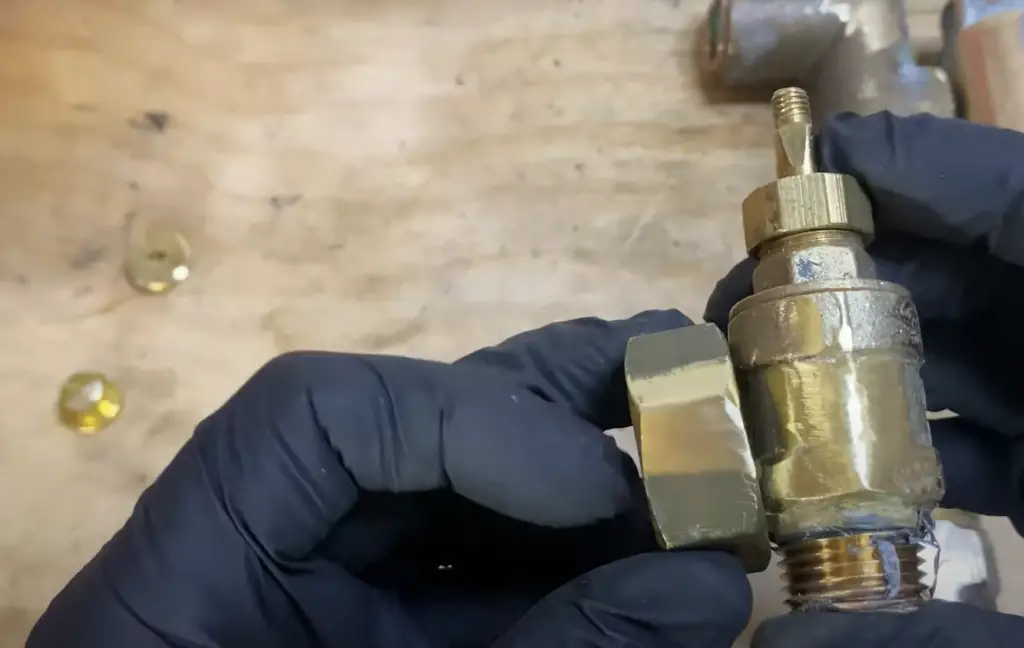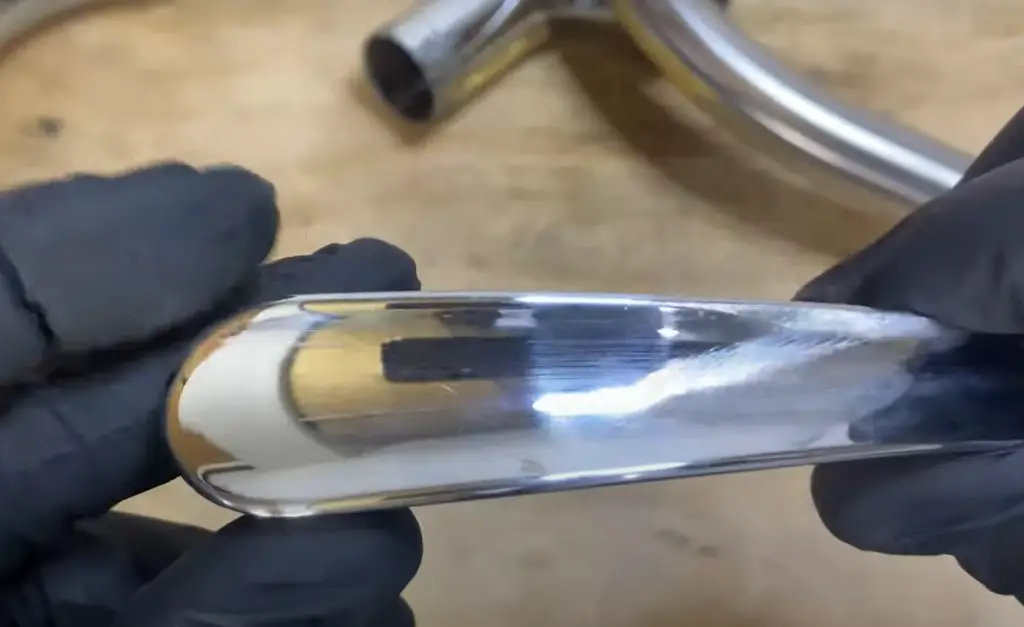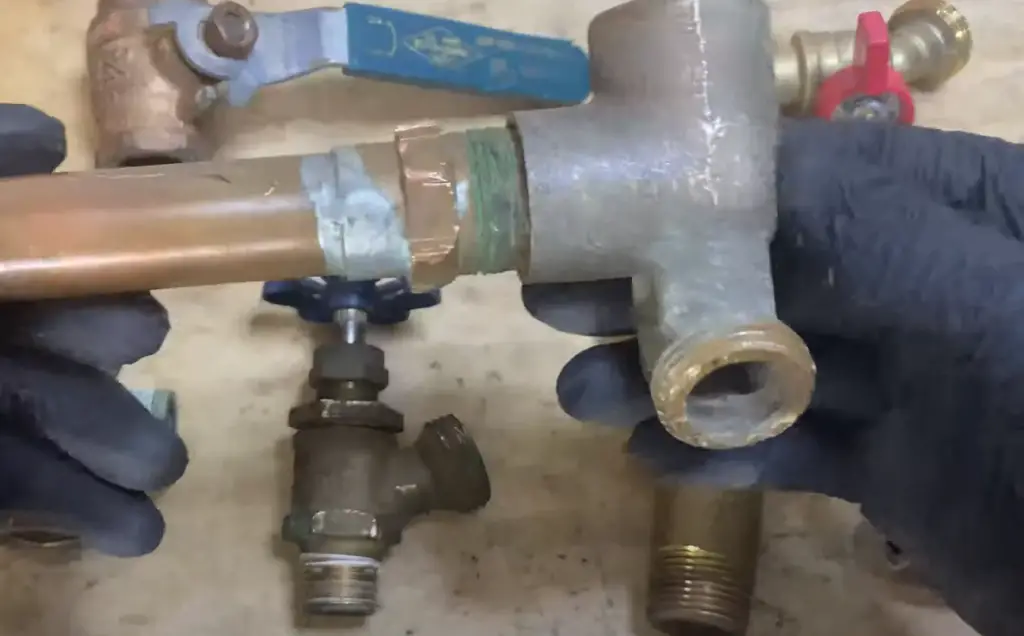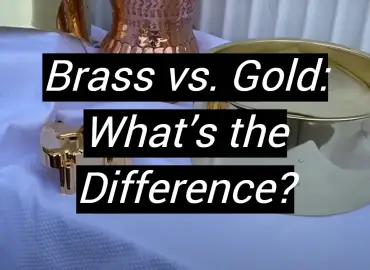Some people think that red brass and yellow brass are different. But they are not that different. People have been arguing about this for a long time, but it is not as confusing as it seems. You can easily understand the difference between red brass and yellow brass (and which one to use for your project).
This blog post will explain both types of brass. We’ll tell you what they’re made of and what properties they have. By the time you finish reading, you’ll know everything about these two kinds of metal.
What is Considered Red Brass?
Red brass is a metal made from copper and zinc. There is more copper than zinc in red brass. There are also small amounts of lead, tin, and other elements in red brass.
Red brass looks reddish compared to regular brass, which looks yellow. People use red brass for things like fittings and hardware because it is strong and does not corrode easily.

Red brass is a good metal to use for plumbing because it doesn’t get rusty when it touches water. It also works well for things that need to conduct heat, like radiators and hot water tanks. Sometimes people also use red brass because it looks nice.
What is Red Brass Made of?
Red brass is made up of about 85 percent copper and 15 percent zinc. It also has small amounts of lead, nickel, and other elements. The amount of these other elements varies from type to type.
The mix of metals gives red brass its reddish colour and makes it stronger than regular yellow brass. It’s also more resistant to corrosion and wear.
Physical and Mechanical Properties of Red Brass
Red brass is stronger than yellow brass. This means it can last longer and handle more pressure before breaking or changing shape.
Red brass can also withstand higher temperatures than yellow brass, making it a good choice for items like radiators that need to be able to stand up to heat.
It’s also non-magnetic and has good electrical conductivity. This makes it a great choice for things like switches, wires, and plugs.
This means it won’t rust or corrode easily when exposed to water or other liquids. It’s a great metal to use in plumbing because it won’t wear away quickly over time.Red Brass Price
Red brass costs more than yellow brass. This is because it has more copper and other elements, making it more expensive to make.
The price also depends on the quality, quantity, and type of red brass you are looking for. Red brass is more expensive than yellow brass, but it lasts longer and does not corrode as easily.
What is Yellow Brass?
Yellow brass is a metal made from copper and zinc. There is more zinc than copper in yellow brass, which makes it look yellowish compared to red brass.
People use yellow brass for things like musical instruments because it is softer and easier to work with than red brass.
Yellow brass is a good metal to use for decorative items or musical instruments because it is easy to shape and polish. It also produces a bright, clear sound.
What is Yellow Brass Made Of?
Yellow brass is made of 70% copper and 30% zinc. It also has small amounts of tin, lead, nickel, and other elements. The amount of these other elements varies depending on the type of yellow brass.
Physical and Mechanical Properties of Yellow Brass
Yellow brass is softer than red brass and easier to shape. This makes it a good choice for things like pretty decorations or musical instruments. It also does not attract magnets, so it is good for electrical parts too.

Yellow brass is not as corrosion-resistant as red brass. This means it is not a good choice for items that need to be able to stand up to water or other liquids, like plumbing fixtures.
Yellow Brass Price
Yellow brass costs less than red brass. This is because it has less copper and other elements. The price of yellow brass also depends on the quality, quantity, and type of yellow brass you are looking for. Yellow brass is not as strong as red brass and it can corrode more easily.
Yellow Brass Properties
Red brass and yellow brass have some things in common and some things that are different. They are both strong, non-magnetic, and good for conducting electricity.
However, red brass is stronger than yellow brass, more corrosion-resistant, and better able to withstand high temperatures. Red brass is also more expensive than yellow brass.
Similarities Between Red Brass and Yellow Brass
Red brass and yellow brass both have excellent electrical conductivity, making them great choices for switches, wires, and plugs. They are also non-magnetic and won’t attract magnets.
This means it can last longer and handle more pressure before breaking or changing shape. Red brass can also withstand higher temperatures than yellow brass.Differences Between Red Brass and Yellow Brass
Red brass is more corrosion-resistant than yellow brass. This makes it a better choice for items like plumbing fixtures that need to be able to stand up to water or other liquids.

Yellow brass is softer than red brass. This means it is easy to shape into different things. It is good for making things that are pretty or for musical instruments. But it is not as good for making things that need to be strong and durable, like radiators.
Red brass is more expensive than yellow brass because it has more copper and other elements. The price also depends on the quality, quantity, and type of metal you are looking for.[1]
FAQ
What is red brass used for?
Red brass is used for many different things, such as: electrical parts, plumbing fixtures, radiators, and decorative items. It is also a good choice for items that need to be strong and durable.
What is yellow brass used for?
Yellow brass is usually used to make musical instruments, decorations, and some electrical parts because it is easy to shape and polish.
Is yellow brass as strong as red brass?
No, yellow brass is softer than red brass and not as strong. It can handle less pressure before breaking or changing shape. Red brass is the better choice for items that need to be strong and durable.
Is yellow brass corrosion resistant?
No, yellow brass is not as corrosion-resistant as red brass.

This means it is not the best choice for items that need to be able to stand up to water or other liquids, like plumbing fixtures. Red brass is a better choice for this type of application.
How can you tell red brass from yellow?
You can tell the difference between red brass and yellow brass by looking at them. Red brass is red and yellow brass is gold.
You can also test if something is red brass or yellow brass by seeing if it is a good conductor of electricity or if a magnet sticks to it.
Are valves red brass or yellow brass?
The colour of the valve depends on what it is made from. Valves can be red or yellow if they are made from brass. The valves that are used in plumbing systems are usually made from red brass because it is stronger and does not corrode as easily.
Is red brass strong?
Yes, red brass is stronger than yellow brass. It can also handle more pressure and is corrosion-resistant. This makes it a great choice for items that need to be both strong and long-lasting.
Is red brass expensive?
Yes, red brass is more expensive than yellow brass because it has more copper and other elements. The price also depends on the quality, quantity, and type of metal you are looking for.
What is the difference between red brass and chrome plated brass?
Red brass and chrome plated brass are both made of brass, but they are not the same. Red brass is a darker shade of copper with more zinc than yellow brass. Chrome plating is a coating that is applied to brass to give it a shiny finish.
It doesn’t change the properties of the brass. Chrome plated brass is not as strong or corrosion-resistant as red brass and doesn’t last as long. It is mainly used for decorative purposes.
Why is red brass more expensive than yellow brass?
Red brass is more expensive than yellow brass because it has more copper and other elements. The price also depends on the quality, quantity, and type of metal you are looking for.
Red brass is a better choice for items that need to be strong and durable, like radiators or plumbing fixtures, so it may be more expensive than yellow brass.
Does red brass rust?
No, red brass does not rust. It is more corrosion-resistant than yellow brass, which makes it a great choice for items that will be exposed to water or other liquids. Red brass is also stronger and less likely to break or change shape under pressure.
Do different types of brass have different properties?
Yes, there are different types of brass. Each type has different properties. For example, red brass is stronger and does not corrode as much as yellow brass. Red brass is good for things that need to be strong and last a long time, like radiators or plumbing fixtures.

Yellow brass is softer and can be shaped and polished more easily. It is usually used for musical instruments, decorations, and some electrical parts. Chrome plated brass has a shiny coating but it is not as strong or durable as red or yellow brass. Chrome plated brass is mainly used for decoration.
Can you weld red brass?
Yes, you can weld red brass. The welding process needs to be done with care and precision since it is a more difficult metal to weld.
Does red brass tarnish?
No, red brass does not get dirty. It is more corrosion resistant than yellow brass and does not corrode or break down easily. This makes it a great choice for items that need to be strong and last a long time, like radiators or plumbing fixtures.
What is the best way to clean red brass?
The best way to clean red brass is to use a mild detergent and warm water. You can also use cleaning products that are only for brass. Another option is vinegar or lemon juice.
It is bad to use abrasive cleaning products, such as steel wool or scouring pads, because it hurts the metal. After you finish cleaning, always rinse and dry the brass so it does not rust.
Are red brass fittings more expensive?
Red brass fittings are more expensive than yellow brass fittings because they last longer and do not corrode as easily. They also require more specialised equipment for installation and repair, which can add to the cost.
However, red brass fittings are a good investment since they will last longer and require less maintenance over time.
Why is red brass used in plumbing?
Red brass is used in plumbing because it is strong and does not corrode. Yellow brass will corrode and break down over time, but red brass will last longer.
Red brass also has a higher melting point, which means it can be used for hot water applications. Additionally, red brass fittings are easy to install and can be used in many different types of plumbing applications.
Can red brass be recycled?
Yes, red brass can be recycled. However, it is important to note that each type of metal requires different recycling techniques. Depending on the type of brass, the recycling process could involve melting down the material or separating the different metals.
It is also important to know that many scrap yards do not accept brass as it is considered a hazardous material. It is best to check with your local recycling centre before disposing of any red brass.
How do I know which type of brass is best for my project?
There are different types of brass. Think about what the project needs. Things to think about include how strong it needs to be, how long it will last without rusting, and cost. You also need to make sure that the type of brass you choose is allowed by local rules and regulations.
In general, red brass works better for projects that need to be strong and yellow brass is better for projects where it needs to be polished or shaped like a musical instrument.
What are the advantages and disadvantages of red brass?
Red brass is strong and durable. It does not corrode, can withstand high temperatures, and can be used in hot water applications.
The main disadvantage of red brass is that it is more expensive than yellow brass, requires specialised equipment for installation or repair and cannot be recycled easily.
Additionally, it is not as malleable as yellow brass and cannot be polished or shaped the same way.
Why is red brass a better choice than yellow brass?
Red brass is a better choice for projects because it is strong and durable. It does not corrode as easily, can withstand high temperatures and hot water applications, and lasts longer.
Yellow brass is more malleable, so it can be polished or shaped like a musical instrument but it will corrode and break down over time. The cost of red brass is higher than yellow brass, but since it lasts longer and requires less maintenance, it is a better investment.
How do I ensure that my red brass fittings last longer?
To make your red brass fittings last longer, use a mild detergent and warm water when cleaning them. Do not use abrasive cleaners, such as steel wool or scouring pads. Rinse the fitting off with water and dry it completely after you finish cleaning it so it does not rust.
Additionally, seal any connections properly so that water and other elements do not get in and damage the fittings.
Finally, check your brass fittings periodically for signs of wear and tear so you can address any issues before they become a major problem.
Useful Video: How to SCRAP BRASS!!! Difference between RED & YELLOW, STAINLESS & CHROME PLATED, and CLEAN vs DIRTY
Conclusion
In general, there are many important differences between red and yellow brass. Red brass does a better job of resisting corrosion and it is much harder than yellow brass. This makes red brass a good choice for projects such as industrial valves and pipes.
There are two types of brass: yellow and red. Yellow brass is more malleable, which means it can be made into different shapes. This makes it a good choice for things like door knobs and door hardware that need to look nice. But you should still know about both types of brass before choosing one for your next project. Whichever option you choose, you can be sure that the brass will be high quality and last a long time!
Now that we have talked about the differences between red and yellow brass, why not start exploring what you can do with them? And if you’re not sure which type of brass is best for what you want to do, check out our wide selection of bronze products.
References:
- https://www.rocheindustry.com/red-brass-vs-yellow-brass/






